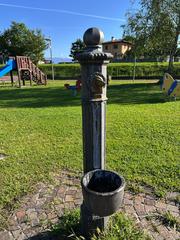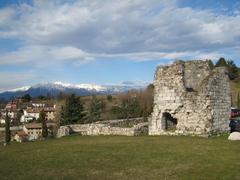Visiting Hours and Ticket Information for Celtic Hypogeum, Udine
Date: 16/08/2024
Introduction
Nestled in the Friuli-Venezia Giulia region of Northern Italy, the Celtic Hypogeum in Cividale del Friuli is a subterranean structure shrouded in mystery and historical significance. This ancient site, likely dating back to the pre-Roman era, offers a glimpse into the past with its rough-hewn chambers and enigmatic layout. The town of Cividale del Friuli, founded by Julius Caesar in 50 B.C., is enriched by this unique archaeological wonder, which is believed to have been constructed by the Celts (Ancient Origins).
This comprehensive guide aims to provide all the necessary information for those planning to visit the Celtic Hypogeum, including visiting hours, ticket details, travel tips, and nearby attractions. Additionally, it covers the cultural and historical impact of the Hypogeum, making it an indispensable resource for history enthusiasts and curious travelers alike.
Table of Contents
- [Origins and Construction](#origins-and-constructionorigins-and-construction)
- [Architectural Layout](#architectural-layoutarchitectural-layout)
- [Possible Functions](#possible-functionspossible-functions)
- [Acoustic Phenomena](#acoustic-phenomenaacoustic-phenomena)
- [Visitor Information: Visiting Hours, Tickets, and Accessibility](#visitor-information-visiting-hours-tickets-and-accessibilityvisitor-information-visiting-hours-tickets-and-accessibility)
- [Nearby Attractions and Guided Tours](#nearby-attractions-and-guided-toursnearby-attractions-and-guided-tours)
- [Photographic Spots](#photographic-spotsphotographic-spots)
- [Cultural and Historical Impact](#cultural-and-historical-impactcultural-and-historical-impact)
- [Modern Research and Tourism](#modern-research-and-tourismmodern-research-and-tourism)
- [FAQ Section](#faq-sectionfaq-section)
- [Conclusion](#conclusionconclusion)
Origins and Construction
The Celtic Hypogeum in Cividale del Friuli, located in the Friuli-Venezia Giulia region of Northern Italy, is a subterranean structure of mysterious origins. The town of Cividale del Friuli itself was founded by Julius Caesar in 50 B.C., but the Hypogeum predates this period, likely dating back to the pre-Roman era, possibly constructed by the Celts (Ancient Origins). The structure is carved directly into the rock using primitive techniques, primarily through axe blows, which is evident from the rough-hewn walls and niches within the chambers (FullTravel).
Architectural Layout
The Hypogeum consists of a central chamber from which three smaller chambers branch off. The main chamber, referred to as Chamber A, is accessible via a steep, double-curved staircase descending from a small door in a private building on the banks of the Natisone River (Preistoria in Italia). The smaller chambers are labeled B, C, D, and E. The layout is roughly K-shaped, with various niches, shelves, and benches carved into the rock, adding to the enigmatic nature of the site (Ancient Origins).
Possible Functions
The exact purpose of the Celtic Hypogeum remains a subject of debate among scholars. Several theories have been proposed, each supported by different archaeological findings and historical contexts:
- Burial Site: Some scholars suggest that the Hypogeum was used as a burial chamber during the Celtic era. This theory is supported by the presence of niches that may have contained piles of bones (Ancient Origins).
- Prison: During Roman and Longobard times, the Hypogeum may have served as a prison. The confined and dark nature of the chambers supports this hypothesis (e-borghi).
- Ritual Baths: Around the 10th century, the Hypogeum might have been used by the Jewish community for ritual baths. The presence of water filtering through the rock and sometimes submerging the floors of two rooms lends credence to this theory (Preistoria in Italia).
- Religious Ceremonies: The acoustic properties of the Hypogeum suggest it may have been used for religious ceremonies. The chambers are tuned to specific frequencies (94 Hz and 102 Hz), which enhance the resonance of a male voice, possibly for singing or praying (Ancient Origins).
Acoustic Phenomena
One of the most intriguing aspects of the Celtic Hypogeum is its acoustic properties. The resonance phenomena present in chambers C and D create remarkable sound effects, allowing sound to travel through the chambers as if the person speaking is right next to you. This archaeo-acoustic feature has been a subject of modern research, revealing that the chambers are tuned to specific frequencies that amplify the human voice (Ancient Origins). This unique characteristic adds to the mystery of the Hypogeum’s original function and the technological prowess of its builders.
Visitor Information: Visiting Hours, Tickets, and Accessibility
The Celtic Hypogeum is well-preserved and maintained by the Municipality of Cividale del Friuli. Visitors can access the site for free by obtaining the keys from the Informacittà desk or the Longobard Temple (Preistoria in Italia). The main chamber measures approximately 6.15 meters by 2.90 meters, providing a compact yet fascinating glimpse into ancient subterranean architecture (Ancient Origins).
Opening Hours: The Hypogeum is open to visitors throughout the year. However, it is advisable to check the official website or contact the local tourist office for the most up-to-date information on visiting hours.
Tickets: Entry to the Celtic Hypogeum is free, but visitors must obtain keys from designated locations.
Travel Tips: Comfortable shoes are recommended due to the steep and narrow staircases. Carry a flashlight to better explore the dimly lit chambers.
Accessibility: The Hypogeum is not wheelchair accessible due to its ancient and rugged structure. Visitors with mobility issues may find it challenging to navigate the site.
Nearby Attractions and Guided Tours
Cividale del Friuli is rich in historical landmarks and attractions. Nearby sites include the Longobard Temple, the Devil’s Bridge, and the National Archaeological Museum. Guided tours are available and provide deeper insights into the history and significance of these sites.
Photographic Spots
The Hypogeum offers unique photographic opportunities, particularly for those interested in ancient architecture and subterranean structures. The interplay of light and shadow within the chambers can result in captivating images.
Cultural and Historical Impact
The Celtic Hypogeum is not only a testament to ancient engineering but also a significant cultural and historical landmark. Its enigmatic nature has fueled local legends and stories, contributing to the cultural heritage of Cividale del Friuli. The town itself, with its medieval charm and historical significance, attracts tourists who are keen to explore its rich past (Palazzo de Nordis).
Modern Research and Tourism
Modern technology has allowed researchers to delve deeper into the mysteries of the Hypogeum. Archaeo-acoustic studies have provided insights into the acoustic properties of the chambers, while archaeological research continues to explore its origins and functions. Tourists visiting the Hypogeum can experience these phenomena firsthand, making it a unique and memorable part of their visit to Cividale del Friuli (Ancient Origins).
FAQ Section
1. What are the visiting hours for the Celtic Hypogeum?
Visiting hours may vary, so it’s best to check the official website or contact the local tourist office for the most current information.
2. Do I need to purchase tickets to visit the Hypogeum?
No, entry to the Hypogeum is free. Visitors need to obtain keys from designated locations.
3. Is the Hypogeum accessible to everyone?
Due to its ancient and rugged structure, the Hypogeum is not wheelchair accessible and may be challenging for visitors with mobility issues.
4. Are there guided tours available?
Yes, guided tours are available and can provide more detailed insights into the history and significance of the Hypogeum and nearby attractions.
Conclusion
The Celtic Hypogeum of Cividale del Friuli remains an enigmatic and fascinating site, rich in history and cultural significance. Its mysterious origins, unique architectural features, and remarkable acoustic properties continue to captivate scholars and tourists alike. As a part of the broader historical and cultural landscape of Cividale del Friuli, the Hypogeum offers a unique window into the past, inviting visitors to explore and ponder its many mysteries.
References
- Ancient Origins. (n.d.). Subterranean wonder: The Celtic Hypogeum. Ancient Origins
- FullTravel. (n.d.). Guide: Ipogeo celtico di Cividale del Friuli. FullTravel
- Preistoria in Italia. (n.d.). Ipogeo celtico di Cividale del Friuli (UD). Preistoria in Italia
- Where and When. (n.d.). Best time to visit Udine, Italy. Where and When
- e-borghi. (n.d.). Celtic Hypogeum. e-borghi



